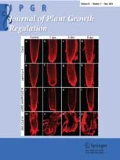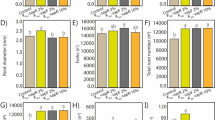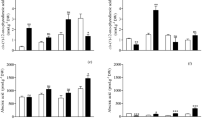Abstract
The effect of a seaweed-derived biostimulant (Kelpak® at 1, 2.5 and 5 % dilution; v/v) on the growth, endogenous cytokinin (CK) and phytochemical content in Eucomis autumnalis (Mill.) Chitt. under hydroponic conditions was evaluated. After 4 months, the stimulatory effect of Kelpak® treatments was more noticeable in the underground organs than in the aerial organs. Total endogenous CK was also higher in plants treated with Kelpak® (c.a. 1000–1200 pmol g−1 DW) compared to control plants (860 pmol g−1 DW). Isoprenoid CKs (which mainly accumulated in the aerial organs) were more dominant than aromatic-type CKs across all the treatments. A total of 11 bioactive chemicals (8 phenolic acids and 3 flavonoids) and eucomic acid known for their diverse biological activities were quantified in the samples. The most abundant compound was p-coumaric acid (6.5 µg g−1 DW) and it was approximately sevenfold higher in 2.5 % Kelpak®-treated plants than in the control. It was also noteworthy that syringic acid only occurred in the underground organs of 5 % Kelpak®-treated plants. Eucomic acid which is a major bioactive compound in E. autumnalis was significantly enhanced in Kelpak® treatments, and the leaves accounted for more than 70 % of the overall content. Thus, Kelpak® elicited a significant influence on the growth, endogenous CK and phytochemical content in E. autumnalis. These findings provide additional evidence of the enormous potential of Kelpak® as a useful biostimulant with practical applications in various agricultural endeavours.






Similar content being viewed by others
References
Alain-Michel B (2007) Evolution and current status of research in phenolic compounds. Phytochemistry 68:2722–2735
Aremu AO, Masondo NA, Van Staden J (2014) Physiological and phytochemical responses of three nutrient-stressed bulbous plants subjected to vermicompost leachate treatment. Acta Physiol Plant 36:721–731
Aremu AO, Masondo NA, Rengasamy KRR, Amoo SO, Gruz J, Bíba O, Šubrtová M, Pěnčík A, Novák O, Doležal K, Van Staden J (2015) Physiological role of phenolic biostimulants isolated from brown seaweed Ecklonia maxima on plant growth and development. Planta 241:1313–1324
Arthur GD, Aremu AO, Moyo M, Stirk WA, Van Staden J (2013) Growth-promoting effects of a seaweed concentrate at various pH and water hardness conditions. S Afr J Sci 109:39–44
Bajguz A, Piotrowska A (2009) Conjugates of auxin and cytokinin. Phytochemistry 70:957–969
Canter PH, Thomas H, Ernst E (2005) Bringing medicinal plants into cultivation: opportunities and challenges for biotechnology. Trends Biotechnol 23:180–185
Chen AY, Chen YC (2013) A review of the dietary flavonoid, kaempferol on human health and cancer chemoprevention. Food Chem 138:2099–2107
Craigie JS (2011) Seaweed extract stimuli in plant science and agriculture. J Appl Phycol 23:371–393
Croker SJ, Gaskin P, Hedden P, MacMillan J, MacNeil KAG (1994) Quantitative analysis of gibberellins by isotope dilution mass spectrometry: a comparison of the use of calibration curves, an isotope dilution fit program and arithmetical correction of isotope ratios. Phytochem Anal 5:74–80
Crouch IJ, Van Staden J (1994) Commercial seaweed products as biostimulants in horticulture. J Home Consum Hortic 1:19–73
Depuydt S, Hardtke CS (2011) Hormone signalling crosstalk in plant growth regulation. Curr Biol 21:R365–R373
Frébort I, Kowalska M, Hluska T, Frébortová J, Galuszka P (2011) Evolution of cytokinin biosynthesis and degradation. J Exp Bot 62:2431–2452
Gruz J, Novák O, Strnad M (2008) Rapid analysis of phenolic acids in beverages by UPLC–MS/MS. Food Chem 111:789–794
Gülçin İ (2012) Antioxidant activity of food constituents: an overview. Arch Toxicol 86:345–391
Heleno SA, Martins A, Queiroz MJRP, Ferreira ICFR (2015) Bioactivity of phenolic acids: metabolites versus parent compounds: a review. Food Chem 173:501–513
Horgan R (1992) Present and future prospects for cytokinin research. In: Kamínek M, Mok DWS, Zažímalová E (eds) Physiology and biochemistry of cytokinins in plants. SPB Academic Publishing, Hague
Jayaraj J, Wan A, Rahman M, Punja ZK (2008) Seaweed extract reduces foliar fungal diseases on carrot. Crop Protect 27:1360–1366
Kannan RRR, Aderogba MA, Ndhlala AR, Stirk WA, Van Staden J (2013) Acetylcholinesterase inhibitory activity of phlorotannins isolated from the brown alga, Ecklonia maxima (Osbeck) Papenfuss. Food Res Int 54:1250–1254
Koorbanally C, Crouch NR, Mulholland DA (2006) The phytochemistry and ethnobotany of the southern African genus Eucomis (Hyacinthaceae: Hyacinthoideae). In: Imperato F (ed) Phytochemistry: Advances in research. Research Signpost, Kerala
Kumar N, Pruthi V (2014) Potential applications of ferulic acid from natural sources. Biotechnol Rep 4:86–93
Lubbe A, Verpoorte R (2011) Cultivation of medicinal and aromatic plants for specialty industrial materials. Ind Crops Prod 34:785–801
Murashige T, Skoog F (1962) A revised medium for rapid growth and bio assays with tobacco tissue cultures. Physiol Plant 15:473–497
Novák O, Hauserová E, Amakorová P, Doležal K, Strnad M (2008) Cytokinin profiling in plant tissues using ultra-performance liquid chromatography—electrospray tandem mass spectrometry. Phytochemistry 69:2214–2224
Okada M, Park S, Koshizawa T, Ueda M (2009) (R)-Eucomic acid, a leaf-opening factor of the model organism, Lotus japonicus. Tetrahedron 65:2136–2141
Pant AP, Radovich TJK, Hue NV, Talcott ST, Krenek KA (2009) Vermicompost extracts influence growth, mineral nutrients, phytonutrients and antioxidant activity in pak choi (Brassica rapa cv. Bonsai, Chinensis group) grown under vermicompost and chemical fertiliser. J Sci Food Agr 89:2383–2392
Papenfus HB, Stirk WA, Finnie JF, Van Staden J (2012) Seasonal variation in the polyamines of Ecklonia maxima. Bot Mar 55:539–546
Papenfus HB, Kulkarni MG, Stirk WA, Finnie JF, Van Staden J (2013) Effect of a commercial seaweed extract (Kelpak®) and polyamines on nutrient-deprived (N, P and K) okra seedlings. Sci Hortic 151:142–146
Rittenberg D, Foster GL (1940) A new procedure for quantitative analysis by isotope dilution, with application to the determination of amino acids and fatty acids. J Biol Chem 133:737–744
Robertson-Andersson DV, Leitao D, Bolton JJ, Anderson RJ, Njobeni A, Ruck K (2006) Can kelp extract (KELPAK®) be useful in seaweed mariculture? J Appl Phycol 18:315–321
Sakakibara H (2006) Cytokinins: activity, biosynthesis, and translocation. Annu Rev Plant Biol 57:431–449
Santner A, Calderon-Villalobos LIA, Estelle M (2009) Plant hormones are versatile chemical regulators of plant growth. Nat Chem Biol 5:301–307
Sharma HSS, Fleming C, Selby C, Rao JR, Martin T (2014) Plant biostimulants: a review on the processing of macroalgae and use of extracts for crop management to reduce abiotic and biotic stresses. J Appl Phycol 26:465–490
Stirk WA, Van Staden J (2010) Flow of cytokinins through the environment. Plant Growth Regul 62:101–116
Stirk WA, Arthur GD, Lourens AF, Novák O, Strnad M, Van Staden J (2004) Changes in cytokinin and auxin concentrations in seaweed concentrates when stored at an elevated temperature. J Appl Phycol 16:31–39
Stirk WA, Tarkowská D, Turečová V, Strnad M, Van Staden J (2014) Abscisic acid, gibberellins and brassinosteroids in Kelpak®, a commercial seaweed extract made from Ecklonia maxima. J Appl Phycol 26:561–567
Strnad M (1997) The aromatic cytokinins. Physiol Plant 101:674–688
Tilman D, Cassman KG, Matson PA, Naylor R, Polasky S (2002) Agricultural sustainability and intensive production practices. Nature 418:671–677
Troell M, Robertson-Andersson D, Anderson RJ, Bolton JJ, Maneveldt G, Halling C, Probyn T (2006) Abalone farming in South Africa: an overview with perspectives on kelp resources, abalone feed, potential for on-farm seaweed production and socio-economic importance. Aquaculture 257:266–281
Wang Y, Frei M (2011) Stressed food—The impact of abiotic environmental stresses on crop quality. Agric Ecosyst Environ 141:271–286
Wang D, Shi Q, Wang X, Wei M, Hu J, Liu J, Yang F (2010) Influence of cow manure vermicompost on the growth, metabolite contents, and antioxidant activities of Chinese cabbage (Brassica campestris ssp. chinensis). Biol Fertil Soils 46:689–696
Zalabák D, Pospíšilová H, Šmehilová M, Mrízová K, Frébort I, Galuszka P (2013) Genetic engineering of cytokinin metabolism: prospective way to improve agricultural traits of crop plants. Biotechnol Adv 31:97–117
Acknowledgments
The Claude Leon Foundation, University of KwaZulu-Natal and National Research Foundation, South Africa are thanked for financial support. This work was also financed by the Ministry of Education, Youth and Sport of the Czech Republic (Grant LO1204 from the National Program of Sustainability, Operational Program Education for Competitiveness—European Social Fund (Project CZ.1.07/2.3.00/20.0165) and the Program “Návrat” for Research, Development, and Innovations, no. LK21306) as well as by the Internal Grant Agency of Palacký University (IGA_PrF_2015_024). We thank Mrs Alison Young (UKZN Botanical Garden, Pietermaritzburg, South Africa) and her Staff for their assistance in maintaining the greenhouse facilities.
Author information
Authors and Affiliations
Corresponding author
Rights and permissions
About this article
Cite this article
Aremu, A.O., Plačková, L., Gruz, J. et al. Seaweed-Derived Biostimulant (Kelpak®) Influences Endogenous Cytokinins and Bioactive Compounds in Hydroponically Grown Eucomis autumnalis . J Plant Growth Regul 35, 151–162 (2016). https://doi.org/10.1007/s00344-015-9515-8
Received:
Accepted:
Published:
Issue Date:
DOI: https://doi.org/10.1007/s00344-015-9515-8




